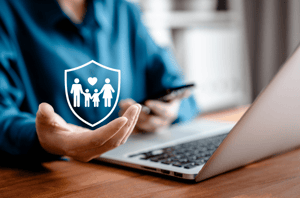As technology becomes increasingly integrated into daily life, parents must equip their children with the necessary tools to stay safe in the digital world. Alarming statistics from the FBI Internet Crime Center reveal a concerning surge in cybercrime against children, with nearly 20% more child victims reported in 2022 than the previous year.
Shockingly, seven children per day faced online exploitation in 2022 alone. This decade has witnessed almost 8,000 child victims of cybercrime, indicating that over half of these incidents occurred in the last three years. In this article, we will explore essential steps to empower children with cybersecurity knowledge, ensuring a safer online experience.
Today’s children are online, but what are we doing to teach kids about cybersecurity and online safety?
Today’s kids are growing up in a digital era, surrounded by technology from an early age. Even before the Coronavirus pandemic in 2020, approximately 92% of American children had an online presence before the age of two. This was Initially driven by parents sharing their children’s photos and milestones on social media platforms like Facebook and Instagram. Due to this children were and are inadvertently introduced to the online world starting from their earliest days.
As kids grow, their digital footprint expands, and by age 10, many kids browse the internet without their parent’s knowledge or permission. With teens, access to smartphones is nearly universal, and almost half of them spend an average of nine hours a day online. It’s undeniable—our kids are online.
But herein lies the concern—children, being children, lack the experience and discernment to recognize potential threats in the digital realm, making them susceptible to online stalkers and various forms of cybercrime.
As parents, guardians, and educators, we need to educate and empower them with the knowledge and skills to navigate the virtual landscape safely. In the next section, we’ll delve into some crucial tips and practices that can help parents teach their kids about cybersecurity and ensure their online safety in this ever-evolving digital world.

Table of Contents
7 tips to keep your kids safe online
According to the Centers for Disease Control and Prevention (CDC), children between the ages of eight and 10 dedicate six hours daily to screen time. While not all of that time might be online, the fact remains that kids are exposed to the internet far more than we might realize. Since children’s online presence begins early and access to smartphones becomes commonplace among teens, ensuring our kids’ safety in the virtual world is of utmost importance.
Equipping them with cybersecurity knowledge is essential to protect them from potential cyber threats and online dangers. We’ve gathered seven crucial tips from experts to empower parents to teach their children about online safety and foster responsible digital citizenship.
1. Set clear Internet usage guidelines
Establish clear guidelines for your child’s internet usage, emphasizing responsible behavior and the importance of seeking permission before accessing new websites or apps. Encourage open communication, making sure they feel comfortable discussing any online experiences that may be concerning or uncomfortable.
Children tend to explore the digital world without fully grasping its risks. Setting rules instills a sense of accountability and helps them make safer choices online.
2. Be a role model
Be mindful of your online habits and behaviors as a parent or guardian. In 2021, people, on average, spent 172 minutes per day, checking work-related emails and approximately 149 minutes attending to personal emails. This doesn’t even account for the time parents spend on social media. However, as far as kids are concerned, they just see their parents on the computer.
Children often imitate their elders, and by demonstrating responsible internet usage, they will feel encouraged to follow suit. Avoid oversharing personal information on social media and emphasize respecting others’ privacy online.
When kids see adults practicing safe online behavior, it reinforces the significance of responsible digital citizenship.
3. Teach your child about personal information
Empowering children with knowledge about personal information safeguards them from potential identity theft or exploitation by online predators.
Explain the concept of personal information, such as full names, addresses, phone numbers, and school names, and why it should not be shared with strangers online. Stress the importance of privacy settings on social media platforms to control who can access their information.
4. Recognize the signs of cyberbullying
Educate your child about cyberbullying, its signs, and its impact on others. Encourage them to be empathetic and report any instances of cyberbullying they encounter or witness.
By raising awareness about cyberbullying, children can develop a supportive online community and contribute to a safer digital environment.
Here are some signs that your child might be the victim of cyberbullying:
- Displays signs of nervousness when receiving text, instant messages, or emails.
- Exhibits unease or feigns illness when faced with going to school.
- Reluctance to share information about their online activities.
- Unexplained anger or depression, particularly after being online.
- Abruptly shutting off or leaving the computer unexpectedly during use.
- Withdrawal from real-life friends and family.
- Complaints of unexplained stomachaches or headaches.
- Experiences difficulty sleeping at night.
- Unexplained weight fluctuations.
- Mentions or shows signs of suicidal thoughts or attempts.
5. Beware of suspicious links and messages
Teach your child to recognize and avoid suspicious links, messages, or emails, as they may contain malware or lead to phishing scams. Emphasize the importance of verifying the authenticity of senders and websites before clicking on any links.
Instilling caution when interacting with unknown sources protects kids from falling victim to cybercriminals and potential malware attacks.
6. Practice safe social media usage
Discuss the implications of sharing photos, videos, and personal information on social media platforms. Encourage kids to set their profiles to private, limit their friend lists to people they know, and avoid accepting friend requests from strangers.
By practicing safe social media habits, children can maintain greater control over their online presence and reduce the risk of unwanted attention.
7. Keep your own devices secure
Securing devices is paramount, especially in light of the widespread issue of screen addiction that affects 61% of internet users. Internet addiction cuts across all age groups, with staggering statistics revealing the prevalence among various demographics: 73% for ages 13-17, 71% for ages 18-24, 59% for ages 25-34, 54% for ages 35-44, 40% for ages 45-54, 39% for ages 55-64, and 44% for ages 64 and above.
By emphasizing the importance of password protection and device security, we can protect personal information and instill responsible digital habits, promoting a healthier balance between screen time and real-life engagement.
Help kids put their screen time to positive use
As we navigate the digital landscape with increasing screen time and internet usage, equipping our children with essential computer skills becomes vital. Emphasizing positive applications, like coding, fosters creativity and enhances their understanding of cybersecurity and responsible online behavior.
At CodaKid, we recognize the significance of online safety, and we stand alongside parents in their efforts to keep kids safe in the virtual world. Let us support your child’s journey by exploring our coding courses for kids on the CodaKid website. We can empower the next generation for a bright and secure digital future.
We hope you’ve enjoyed 7 Key Tips to Teach Kids about Cybersecurity and Online Safety. Please feel free to leave comments below!

















